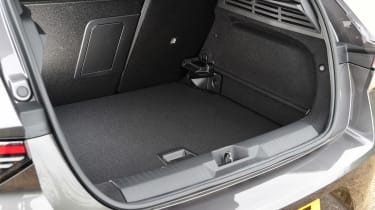Vauxhall Astra review - Practicality & boot space
"The Vauxhall Astra is slightly more practical than its closest rivals"
Family hatchbacks used to serve people’s needs pretty well, but now you can get more practical SUVs for a similar price. Families perusing their local Vauxhall dealer stock may wonder if an Astra will be too cramped, so could end up in a Vauxhall Grandland instead. Those not quite convinced by the SUV hype can also opt for the more-practical Vauxhall Astra Sports Tourer estate; this sacrifices some of the hatchback’s sporty appeal for extra space in the rear. Just like the hatch, it’s available as a plug-in hybrid, too.
Vauxhall Astra interior space & storage
The Vauxhall Astra offers plenty of space for those in the front, but the rear seats feel a little tight. A six-foot-tall adult will likely find their knees squashed against the front seat. It’s by no means the only hatchback that feels like this – it’s more spacious in the back than the Mazda3 – but equally some rivals allow rear-seat occupants to stretch out more. A Skoda Octavia is huge by comparison, and the Volkswagen Golf and Ford Focus offer more knee room. Speccing the Ultimate trim and its standard sunroof will make the cabin feel light and airy, but bear in mind that it’s likely to cut into headroom even more.
More reviews
In-depth reviews
- Vauxhall Astra review - striking hatchback with updated tech
- Vauxhall Astra Sports Tourer review - versatile family estate
- Vauxhall Astra Electric review - household name with an EV twist
- Vauxhall Astra hatchback review (2015-2021)
- Vauxhall Astra Sports Tourer estate (2016-2021)
Used car reviews
The Astra, Focus and Golf are evenly matched for headroom, and there’s plenty of space for feet under the front seats when sat in the back of the Vauxhall, but the Focus beats it for knee room. The Astra also has a smaller transmission tunnel than the Golf (the hump in the middle of the car running the length of the interior), which can be handy if you are carrying three passengers in the back.
Vauxhall’s designers have clearly spent a good deal of time considering interior storage, because there’s a big covered cubby hole between the front seats, generous cup-holders, and another lidded tray ahead of the gearlever. There’s a storage solution for sunglasses below the central air vent too, but a lack of soft material in the door bins means items can rattle over rough surfaces.
Boot space
At 422 litres, the new Astra’s boot is noticeably bigger than the old car, and is around 40 litres more than the Volkswagen Golf, SEAT Leon and Ford Focus. Adding a spare wheel will impact boot space slightly, while the plug-in hybrid gets a smaller 352-litre boot because of the battery’s placement under the floor of the car – not bad compared with 273 litres for the Volkswagen Golf GTE. With the split-folding rear seats down, the hatchback offers 1,339 litres of space when measured to the roof (1,268 for the hybrid). The tailgate looks nice and wide, which should make it easy to load bulky items. The Astra Electric has similar luggage room to the PHEV, measuring 351 litres or 1,268 litres depending on the position of the back seats. It’s a shame that picking the versions with a plug has such an impact on luggage space, especially when rivals like the Renault Megane E-Tech (440 litres) offer more room.
Towing
The diesel engine is the best tow car in the range, being capable of towing a braked trailer weighing up to 1,550kg, or an unbraked one weighing up to 710kg. Manual petrol engines can tow 1,250kg braked or 660kg unbraked, while it may surprise you to find out that the plug-in hybrid can manage 1,450kg and 750kg respectively. Often hybrid cars have a much lower towing capacity than petrol and diesel engines.
Which Is Best?
Cheapest
- Name1.2 Turbo 130 Griffin [Tech Pack] 5dr
- Gearbox typeManual
- RRP£26,590
Most Economical
- Name1.6 Plug-in Hybrid 195 GS 5dr e-DCT7
- Gearbox typeSemi-auto
- RRP£36,035
Fastest
- Name1.6 Plug-in Hybrid GSe 5dr e-DCT7
- Gearbox typeSemi-auto
- RRP£38,665














